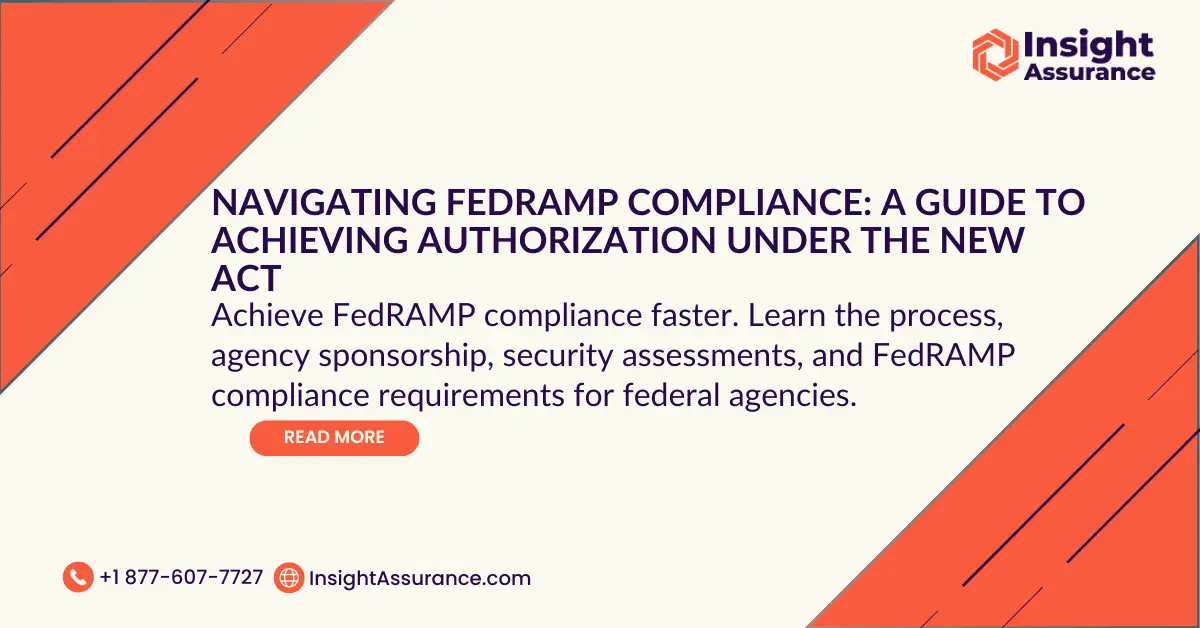As the federal government continues to strengthen its Cloud Smart and Zero Trust initiatives, cloud service providers (CSPs) aiming to deliver cloud service offerings (CSOs) to government agencies must navigate an increasingly complex regulatory environment. The introduction of the FedRAMP Authorization Act has ushered in new refinements to the Federal Risk and Authorization Management Program (FedRAMP) — a critical authorization for CSPs seeking to work with federal agencies.
In this blog post, we’ll explore the latest changes to FedRAMP, their implications for CSPs, and best practices for achieving an Authority to Operate (ATO) under the framework’s evolving changes and updates.
What Hasn’t Changed
Before exploring recent changes, it’s important to highlight what remains the same. Under the FedRAMP program, the first step for CSPs is to define the type of system they will develop — whether it falls under Infrastructure as a Service (IaaS), Platform as a Service (PaaS), or Software as a Service (SaaS).
Next, CSPs must evaluate the services their cloud system will provide and conduct a thorough Federal Information Processing Standard (FIPS) 199 assessment. This assessment identifies the types of information the system will collect, process, transmit, or store, following the NIST 800-60 series guidelines. Once the information types are identified and categorized, the system is categorized as Low Impact (including a tailored approach for LI-SaaS), Moderate Impact, or High Impact. This classification enables the CSP to determine the appropriate security control baseline for the system. With the baseline established, the CSP can then proceed in the authorization process — entering the phase where most of the recent FedRAMP changes take effect. There are no significant changes to the Post Authorization (continuous monitoring) processes.
The changes to the FedRAMP program were introduced through the FedRAMP Authorization Act (FAA), which has now become federal law. This legislation aims to streamline the authorization process, reduce go-to-market delays, and encourage the participation of a broader range of cloud service providers. While security standards have become more stringent, the FAA also ensures greater adoption by federal agencies.
Common Changes to the FedRAMP Program
System Security Package
While the core elements of the security package remain unchanged, the way it is developed has evolved, introducing efficiencies and new requirements under the FAA. These include:
- Comprehensive Documentation: The FAA mandates more detailed and specific security documentation. It is no longer acceptable to reuse generic control language or duplicate control responses across documentation.
- Procedures Requirements: CSPs can now use runbooks, playbooks, and/or plans to meet the procedures requirement for all “-1” controls, ensuring they are aligned within the same security control family.
- Enhanced Diagram Standards: There are significant updates to how system diagrams must be presented, including more detailed requirements on the information they must contain.
Review Timelines
Although security package reviews remain a requirement, the transition to FAA standards which shifts from Joint Authorization Board Provisional ATO (JAB P-ATO) to variations of the Agency ATO process, the existing backlog and transition may initially keep review timelines consistent with past experiences. However, the FAA’s streamlined processes are expected to lead to shorter review times and a faster path to authorization and marketplace designation in the near future.
Authority to Operate (ATO) Changes
The fundamental process for authorizing CSOs under FedRAMP remains unchanged — CSPs must meet security control and FedRAMP requirements, build their system, develop a security package, undergo assessment by a third-party assessment organization (3PAO), have their package reviewed, and obtain an ATO. However, the journey to authorization has evolved.
Before the FAA, CSPs had two ATO paths: the JAB P-ATO or an Agency ATO. Under the FAA, there is now only one authorization route — via federal agency sponsorship — with three distinct entry points:
- Readiness Assessment Path: CSPs can complete a Readiness Assessment report (no federal sponsor required at this stage) and, upon successful 3PAO assessment, be listed on the FedRAMP Marketplace as “FedRAMP Ready.” This designation allows CSPs to begin marketing their cloud service to federal agencies.
- Pre-Authorization Path: CSPs can partner with a federal agency that agrees to sponsor them for an ATO if they meet their required standards. They then enter the Pre-Authorization process (where a federal sponsor is mandatory) and are listed on the marketplace as “In Process” after meeting pre-authorization requirements — without requiring a 3PAO assessment at this stage. This path serves as a stepping stone toward obtaining an agency ATO.
- Full Security Assessment Path: CSPs with an operational system, can partner with a federal agency that may already be using their cloud service and willing to grant an ATO. In this case, the CSP proceeds directly to a full 3PAO assessment while being listed as “In Process” on the marketplace. Upon successful evaluation, the CSP’s service achieves the “Authorized” designation.
The key takeaways for this area is that CSPs must either meet all Readiness Assessment requirements to be listed on the marketplace or secure a federal government agency sponsor to begin ATO activities. Success in this process depends on partnering with a knowledgeable 3PAO, such as Insight Assurance, that offers both consulting and assessment services, ensuring a streamlined path to FedRAMP authorization.
Preparing for the FedRAMP Authorization Process
Getting started with your FedRAMP journey is seamless when CSPs engage the right experts to guide them through the process. Achieving FedRAMP authorization requires navigating three key phases:
- Phase 1: Preparation
CSPs must decide whether to complete the requirements for a Readiness Assessment conducted by a 3PAO — earning the “FedRAMP Ready” designation — or partner with a federal agency to enter the Pre-Authorization phase and meet all pre-authorization requirements.
- Phase 2: Authorization
This phase consists of two critical steps: completing a full security assessment report and undergoing the agency authorization process.
- Phase 3: Continuous Monitoring
Once FedRAMP authorization is achieved, CSPs enter the continuous monitoring phase, where they must fulfill ongoing compliance requirements through monthly, quarterly, semi-annual, and annual reporting to their agency partners.
While these three phases provide a structured path to authorization, CSPs often encounter challenges in interpreting and implementing security controls, aligning with FedRAMP and federal agency requirements, and ensuring compliance with regulations based on the agency’s mission and information types.
Keys to Success
- Start Planning Early: A proactive approach ensures smoother navigation through each phase and reduces costs — such as in the case of Microsoft Azure which will raise its pay as you go prices by 5% across all services. For March, CSPs can lock in the current prices for a period of 3 years
- Engage a 3PAO Early: Involving a 3PAO from the beginning helps mitigate risks and streamline compliance.
- Stay Informed: Understanding and interpreting the latest FAA-driven changes is crucial.
- Involve Key Stakeholders: Collaboration across teams drives efficiency and alignment.
- Adopt a Reusable Approach: If your organization operates under multiple regulatory frameworks, perform a thorough analysis to identify overlap and opportunities for integration. Leveraging existing frameworks — such as NIST, ISO, or CMMC — can streamline implementation, reduce redundancy, and maximize the value of compliance efforts. By aligning requirements across frameworks, organizations can eliminate siloed approaches, saving both time and cost while improving overall security posture.
- Start With the Low Hanging Fruit First: CSPs manage complex environments with multiple teams responsible for different aspects of their cloud service offerings. Instead of tackling all 410 FedRAMP controls simultaneously, break them down into manageable, strategic implementation steps. Grouping controls into digestible categories — such as addressing 50 controls within one area and 35 within another — allows teams to focus on incremental progress, making the compliance process more efficient and less overwhelming. By adopting these strategies, CSPs can optimize their FedRAMP journey, enhance efficiency, and accelerate their path to authorization.
- Leverage Existing Resources: Do Not Reinvent the Wheel: CSPs should take full advantage of the comprehensive resources FedRAMP already provides. From security control baselines to templates and guidelines, these tools are designed to streamline compliance and prevent wasted time and money on unnecessary efforts. Staying informed on upcoming changes and initiatives is critical to ensuring a smooth authorization process. Success in FedRAMP is achieved through compliance, not through well-crafted documentation or the latest technology — especially if those solutions fail to meet FedRAMP’s strict standards. Aligning with established requirements and utilizing available resources will keep CSPs on the right path toward authorization.
- Avoid Costly Mistakes: Understanding before Implementation: CSPs must resist the urge to implement tools and processes before fully understanding FedRAMP requirements. Rushing into implementation without a clear grasp of compliance obligations can lead to noncompliance, wasted resources, and costly rework.
A strategic approach — where CSPs first analyze FedRAMP controls, align them with existing processes, and then implement necessary changes — ensures efficiency and compliance from the start. Thoughtful planning saves time, money, and effort while setting the foundation for a successful authorization. CSPs will see a high return on investment when they take the time to build the right team with the necessary expertise. While maintaining FedRAMP authorization may become a self-sustaining effort over time, the initial stages of the journey require specialized knowledge and strategic guidance. Partnering with experts like Insight Assurance ensures a smooth, efficient path to authorization. With a team of seasoned professionals, CSPs can avoid costly mistakes, streamline compliance efforts, and accelerate their time to market. Investing in expert support early on sets the foundation for long-term success.
The Value of FedRAMP Updates
Recent changes under the FAA have made the authorization process more accessible and efficient. Streamlined procedures increase the likelihood of success, expanded services and funding opportunities enable broader CSP participation, and enhanced security standards strengthen federal agency trust. While initially complex, these new requirements ultimately provide greater assurance and reduce long-term compliance burdens through continuous monitoring.
Navigating FedRAMP’s transformation and achieving authorization is a challenging yet rewarding process. By following a structured approach and partnering with an experienced 3PAO like Insight Assurance, CSPs can confidently navigate the evolving FedRAMP landscape and successfully obtain authorization.
Accelerating Your FedRAMP Authorization Success
Achieving FedRAMP authorization under the FAA demands a deep understanding of the updated requirements, a strategic approach, and expert guidance to navigate the complexities of the framework — transforming an overwhelming process into a manageable one. To ensure success, CSPs must stay ahead of evolving changes and leverage the right resources to drive compliance and meet critical milestones in their authorization journey.
Insight Assurance simplifies and accelerates this process. With a team boasting over 30 years of experience in NIST and DoD risk management frameworks — having mastered cloud security since the first DISA cloud was created — we have been at the forefront of FedRAMP since its inception in 2011. As direct contributors to FedRAMP processes and trusted advisors to the PMO, we guide CSPs from conception to full authorization with precision and efficiency.
Contact Insight Assurance today to take the first step toward becoming FedRAMP-compliant, securing your authorization, and strengthening your presence across federal, state, local, private, and public sectors.

